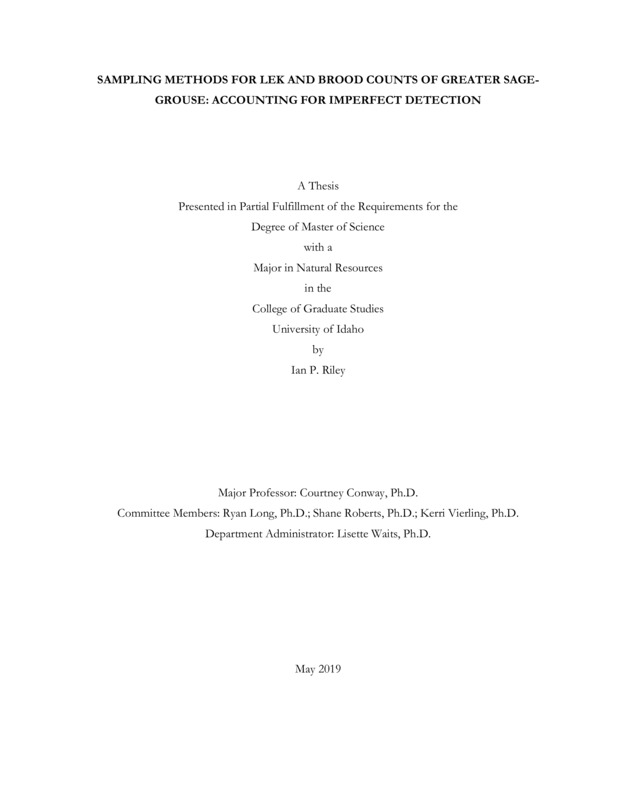SAMPLING METHODS FOR LEK AND BROOD COUNTS OF GREATER SAGE GROUSE: ACCOUNTING FOR IMPERFECT DETECTION
Riley, Ian. (2019-04). SAMPLING METHODS FOR LEK AND BROOD COUNTS OF GREATER SAGE GROUSE: ACCOUNTING FOR IMPERFECT DETECTION. Theses and Dissertations Collection, University of Idaho Library Digital Collections. https://www.lib.uidaho.edu/digital/etd/items/riley_idaho_0089n_11560.html
- Title:
- SAMPLING METHODS FOR LEK AND BROOD COUNTS OF GREATER SAGE GROUSE: ACCOUNTING FOR IMPERFECT DETECTION
- Author:
- Riley, Ian
- ORCID:
- 0000-0002-7164-3148
- Date:
- 2019-04
- Keywords:
- brood count brood productivity Greater sage-grouse lek routes population trends sampling bias
- Program:
- Natural Resources
- Subject Category:
- Wildlife management; Wildlife conservation; Natural resource management
- Abstract:
-
A central component of wildlife conservation and harvest management is accurately estimating population abundance and parameters that influence breeding productivity. Inferences about wildlife population abundance are only accurate if study designs adequately reflect temporal and spatial changes in vital rates. Greater sage-grouse (Centrocercus urophasianus; hereafter, sage-grouse) are a species of conservation concern due to continued population decline since the 1940’s and ongoing threats to their habitat. Currently, investigators use counts of male greater sage-grouse at leks and brood counts of radio-marked hens to indicate annual change in sage-grouse abundance and breeding productivity. Lek and brood counts are essential to inform harvest management, Endangered Species Act listing decisions, and land management policies. However, inferences based on these uncorrected counts may be biased if investigators fail to account for spatial and temporal variation in detection probability.
In chapter 1, we used generalized linear mixed models to estimate the probability of visually and aurally detecting active leks during mock point-count surveys along lek routes. We also examined whether 15 factors influenced aural lek detection and we used a Huggins model to compare aural lek detection probabilities between audio-recording equipment and surveyors. Our results demonstrated that surveyors can aurally detect active leks at greater distances (300% further) compared to visual-only surveys. Our results suggest aural detection probabilities of an active lek were highest near 8 April, within 30 mins of sunrise, on relatively calm and cold days, when surveyors were at higher elevations relative to the lek, in areas of low topographic roughness, during times with no background noise, and on mornings following moonless nights. Audio-equipment had higher lek detection rates compared to real-time surveyors. Our results suggest that 1-min point-count surveys on lek routes would greatly increase detection rates (and reduce bias). To implement 1-min point-count surveys along lek routes, some of the existing lek routes may need to be shortened or split to ensure that the lek routes can be completed during the optimal times when grouse attend leks. By incorporating 1-min point-count surveys at regular intervals along lek routes, surveyors will be more likely to locate all leks along a survey route (including leks that move from one year to another). Therefore, analysts will be able to use the data to produce more accurate estimates of population trends for male sage-grouse.
In chapter 2, we used Cormack-Jolly-Seber (CJS) and Huggins models to estimate survival and detection probabilities of radio-marked hens with broods. Furthermore, we reviewed the sage-grouse literature to summarize brood survey methods used in past studies, including variance, bias, and detection probability associated with each method. We used CJS models to compare brood survival and detection probabilities with data generated from daytime surveys (flush and visual) and nighttime spotlight surveys against a novel brood fecal survey method whereby brood status is assessed indirectly via the presence of brood feces at nighttime roost-sites. A Huggins model was used to estimate differences in detection probabilities among daytime flush surveys, fecal surveys, and nighttime spotlight surveys for broods at 42 days after hatch. We demonstrated that detection probability of daytime surveys (visual and flush surveys) changes with brood age, whereas brood fecal surveys had comparably high detection rates that did not vary with brood age. Our novel brood survey method was as effective as daytime surveys but had a lower probability of flushing hens and their broods (a drawback of daytime brood surveys). Based on our literature review, we need more standardization and rigor in sage-grouse brood survey methods and design. For example, we found only 2 studies that accounted for imperfect detection when using daytime brood surveys to estimate brood or chick survival. We also found wide disparity among studies regarding the metrics they used to determine brood fate, statistical analyses used, and the frequency and duration of monitoring periods used to estimate habitat selection, hen productivity metrics, and estimate brood or chick survival.
Greater sage-grouse are of substantial management concern. Unbiased estimates of sage-grouse population trends, abundance, and breeding productivity metrics are important to prevent inaccurate conclusions and inappropriate management actions. Our results provide managers and future researchers with some potential ways to improve future monitoring efforts and management decisions.
- Description:
- masters, M.S., Natural Resources -- University of Idaho - College of Graduate Studies, 2019-04
- Major Professor:
- Conway, Courtney
- Committee:
- Long, Ryan; Vierling, Kerri; Roberts, Shane
- Defense Date:
- 2019-04
- Identifier:
- Riley_idaho_0089N_11560
- Type:
- Text
- Format Original:
- Format:
- application/pdf
- Rights:
- In Copyright - Educational Use Permitted. For more information, please contact University of Idaho Library Special Collections and Archives Department at libspec@uidaho.edu.
- Standardized Rights:
- http://rightsstatements.org/vocab/InC-EDU/1.0/

